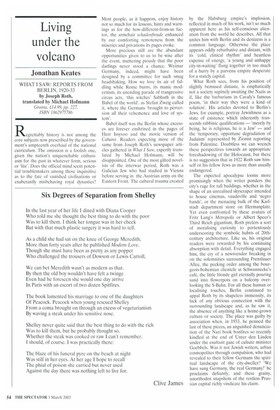Living under the volcano
Jonathan Keates
WHAT I SAW: REPORTS FROM BERLIN, 1920-33 by Joseph Roth, translated by Michael Hofmann Granta, £14.99, pp. 227, ISBN 1862975786 Regrettably history is not among the core subjects now prescribed by the government's umpteenth overhaul of the national curriculum. The omission is a foolish one, given the nation's unquenchable enthusiasm for the past in whatever form, serious or 'lite'. Does the official mind scent potential troublemakers among those inquisitive as to the fate of vanished civilisations or exuberantly misbehaving royal dynasties?
Most people, as it happens, enjoy history not so much for its lessons, hints and warnings as for the how-different-from-us factor, the armchair schadenfreude enhanced by our comforting remoteness from the miseries and privations its pages evoke.
More precious still are the abundant opportunities given to us to be wise after the event, muttering piously that the poor darlings never stood a chance. Weimar Germany, indeed, might have been designed by a committee for such smug headshaking. How we love its air of fiddling while Rome burns, its manic modernism, its unending parade of trangressive circus acts, 'this witches' Sabbath in the Babel of the world', as Stefan Zweig called it, where the Germans 'brought to perversion all their vehemence and love of system'.
Babel itself was the Berlin whose excesses are forever enshrined in the pages of Herr Issyvoo and the movie version of Cabaret. Readers expecting more of the same from Joseph Roth's newspaper articles gathered in What I Saw, expertly translated by Michael Hofmann, will be disappointed. One of the most gifted novelists of the interwar period, Roth was a Galician Jew who had studied in Vienna before serving in the Austrian army on the Eastern Front. The cultural trauma created by the Habsburg empire's implosion, reflected in much of his work, isn't so much apparent here as his self-conscious alienation from the world he describes. All that unites him with Berlin and its denizens is a common language. Otherwise the place appears oddly rebarbative and distant, with its 'cold, clinical rhythm' and heartless expense of energy, 'a young and unhappy city-in-waiting' flung together in too much of a hurry by a parvenu empire desperate for a stately capital.
What Roth sees, from his position of slightly bemused distaste, is emphatically not a society supinely awaiting the Nazis as if, like the barbarians in Cavafy's famous poem, 'in their way they were a kind of solution'. His articles devoted to Berlin's Jews, for example, portray Jewishness as a state of existence which inherently transcends rabbinic qualifications — 'merely by being, he is religious, he is a Jew' — and the 'temporary, opportune degradation of Judaism' represented by Zionist reporting from Palestine. Doubtless we can wrench these perspectives towards an appropriate foreshadowing of the Holocaust, but there is no suggestion that in 1922 Roth saw himself or his fellow Jews as more than usually endangered.
The expected apocalypse looms more promisingly when the writer ponders the city's rage for tall buildings, whether in the shape of an unrealised skyscraper intended to house cinemas, vaudeville and 'negro bands', or the menacing bulk of the Karlstadt department store on Hermanplatz. Yet even confronted by these avatars of Fritz Lang's Metropolis or Albert Speer's Third Reich gigantism, Roth prefers a sort of moralising curiosity to portentously underscoring the symbolic hubris of 20thcentury architecture. Like us, his original readers were rewarded by his continuing absorption with detail. Everything engaged him, the cry of a newsvendor breaking in on the solemnities surrounding Prenzlauer Alice, the pecking order among the bourgeois-bohemian clientele at Schwannecke's café, the little blonde girl eternally pouring sand into flowerpots on a balcony overlooking the S-Bahn. For all these human or localising touches, Berlin continued to appal Roth by its shapeless immensity, its lack of any obvious connection with the surrounding landscape and, as he saw it, the absence of anything like a home-grown culture or society. The place was guilty by association when, in 1933, he penned the last of these pieces, an anguished denunciation of the Nazi book bonfires so recently kindled at the end of Unter den Linden under the exultant gaze of culture minister Goebbels. Was it not Jewish writers, urban cosmopolites through compulsion, who had revealed to their fellow Germans the spiritual landscape of the city-dweller? 'We have sung Germany, the real Germany!' he proclaims defiantly, and these grainy, unorthodox snapshots of the restless Prussian capital richly vindicate his claim.


















































































 Previous page
Previous page